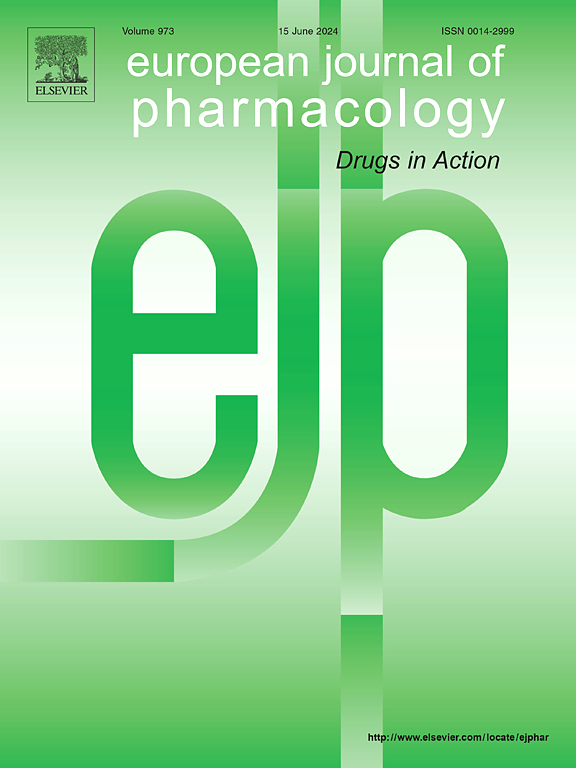Neuroprotective effect of Perillyl alcohol in sporadic Alzheimer's disease in rats
IF 4.2
3区 医学
Q1 PHARMACOLOGY & PHARMACY
引用次数: 0
Abstract
As people age, Alzheimer's disease, a neurological disorder that develops gradually, affects their memory and cognitive abilities. The two hallmarks of Alzheimer's disease are intracellular buildup of neurofibrillary tangles and extracellular β-amyloid plaques. In this work, the effects of Perillyl alcohol on experimental sporadic Alzheimer-type dementia produced by intracerebroventricular streptozotocin were investigated. Rats that received streptozotocin infusion experienced cholinergic hypofunction, increased oxidative-nitritive stress, and impaired memory and learning. Between 15 and 27 days following the initial streptozotocin infusion, 13 days of treatment with Perillyl alcohol (25, 50, and 100 mg/kg p.o.) significantly improved learning and memory in Morris water maze and object recognition test paradigms.
Perillyl also significantly reduced oxidative-nitritive stress, as seen by a decrease in malondialdehyde and nitrite, and restored reduced glutathione and catalase levels. Acetylcholinesterase activity significantly increased in the current model, indicating cholinergic hypofunction and enhanced neuronal cell damage. Treatment with Perillyl alcohol also significantly decreased the increase in acetylcholinesterase activity, indicating that Perillyl alcohol may be able to prevent neuronal damage and restore cholinergic functions. Perillyl alcohol has been shown to improve spatial memory processing, which may be due to its antioxidant properties and capacity to restore cholinergic functioning. However, more study is required to understand the molecular mechanisms of POH that enhance cognition or prevent neurotoxic damage, which could support its application in neuroprotective effect.
紫苏醇对散发性阿尔茨海默病大鼠的神经保护作用
随着人们年龄的增长,阿尔茨海默病,一种逐渐发展的神经系统疾病,会影响他们的记忆和认知能力。阿尔茨海默病的两个标志是细胞内神经原纤维缠结的堆积和细胞外β-淀粉样斑块。本研究探讨紫苏醇对脑室内链脲佐菌素引起的实验性散发性阿尔茨海默型痴呆的影响。接受链脲佐菌素输注的大鼠出现胆碱能功能减退,氧化-氮应激增加,记忆和学习受损。在首次注射链脲佐菌素后15 ~ 27天,紫苏醇(25、50和100 mg/kg p.o)治疗13天,Morris水迷宫和物体识别测试模式的学习和记忆均有显著改善。紫苏叶还显著降低氧化-氮应激,如丙二醛和亚硝酸盐的减少,并恢复减少的谷胱甘肽和过氧化氢酶水平。乙酰胆碱酯酶活性在当前模型中显著升高,表明胆碱能功能减退和神经元细胞损伤加剧。紫苏醇还显著降低了乙酰胆碱酯酶活性的增加,表明紫苏醇可能能够预防神经元损伤并恢复胆碱能功能。紫苏醇已被证明可以改善空间记忆处理,这可能是由于其抗氧化特性和恢复胆碱能功能的能力。然而,POH增强认知或预防神经毒性损伤的分子机制还有待进一步研究,以支持其在神经保护作用中的应用。
本文章由计算机程序翻译,如有差异,请以英文原文为准。
求助全文
约1分钟内获得全文
求助全文
来源期刊
CiteScore
9.00
自引率
0.00%
发文量
572
审稿时长
34 days
期刊介绍:
The European Journal of Pharmacology publishes research papers covering all aspects of experimental pharmacology with focus on the mechanism of action of structurally identified compounds affecting biological systems.
The scope includes:
Behavioural pharmacology
Neuropharmacology and analgesia
Cardiovascular pharmacology
Pulmonary, gastrointestinal and urogenital pharmacology
Endocrine pharmacology
Immunopharmacology and inflammation
Molecular and cellular pharmacology
Regenerative pharmacology
Biologicals and biotherapeutics
Translational pharmacology
Nutriceutical pharmacology.

 求助内容:
求助内容: 应助结果提醒方式:
应助结果提醒方式:


